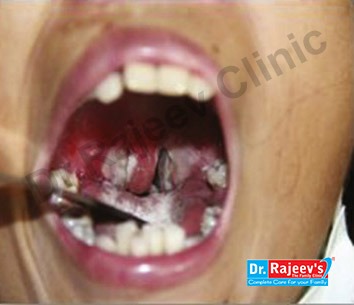

Diphtheria is a serious bacterial infection that usually affects the mucous membranes of nose and throat. Diphtheria is extremely rare in the United States and other developed countries, thanks to widespread vaccination against the disease.
Diphtheria can be treated with medications. But in advanced stages, diphtheria can damage heart, kidneys and nervous system. Even with treatment, diphtheria can be deadly, especially in children.

Diphtheria signs and symptoms usually begin two to five days after a person becomes infected and may include:
In some people, infection with diphtheria-causing bacteria causes only a mild illness — or no obvious signs and symptoms at all. Infected people who remain unaware of their illness are known as carriers of diphtheria, because they can spread the infection without being sick themselves.
A second type of diphtheria can affect the skin, causing pain, redness and swelling similar to other bacterial skin infections. Ulcers covered by a gray membrane also may be skin diphtheria.
Although it's more common in tropical climates, diphtheria on the skin also occurs in the United States, particularly among people with poor hygiene who live in crowded conditions.
Diphtheria is caused by the bacterium Corynebacterium diphtheriae. The bacterium usually multiplies on or near the surface of the throat. C. diphtheriae spreads via:
People who have been infected by the diphtheria bacteria and who haven't been treated can infect people who haven't had the diphtheria vaccine — even if they don't show any symptoms.
People who are at increased risk of contracting diphtheria include:
Diphtheria rarely occurs in the United States and Western Europe, where children have been vaccinated against the condition for decades. However, diphtheria is still common in developing countries where vaccination rates are low.
In areas where diphtheria vaccination is standard, the disease is mainly a threat to unvaccinated or inadequately vaccinated people who travel internationally or have contact with people from less-developed countries.
Left untreated, diphtheria can lead to:
Nerve damage. The toxin can also cause nerve damage. Typical targets are nerves to the throat, where poor nerve conduction may cause difficulty swallowing. Nerves to the arms and legs also may become inflamed, causing muscle weakness.
If the diphtheria toxin damages the nerves that help control muscles used in breathing, these muscles may become paralyzed. At that point, you might need mechanical assistance to breathe.
With treatment, most people with diphtheria survive these complications, but recovery is often slow. Diphtheria is fatal 5% to 10% of the time, according to the World Health Organization. Rates of death are higher in children.
Before antibiotics were available, diphtheria was a common illness in young children. Today, the disease is not only treatable but also preventable with a vaccine.
The diphtheria vaccine is usually combined with vaccines for tetanus and whooping cough (pertussis). The three-in-one vaccine is known as the diphtheria, tetanus and pertussis vaccine. The latest version of this vaccine is known as the DTaP vaccine for children and the Tdap vaccine for adolescents and adults.
The diphtheria, tetanus and pertussis vaccine is one of the childhood immunizations that doctors in the United States recommend during infancy. Vaccination consists of a series of five shots, typically administered in the arm or thigh, given to children at these ages:
After the initial series of immunizations in childhood, you need booster shots of the diphtheria vaccine to help you maintain your immunity. That's because immunity to diphtheria fades with time.
Children who received all of the recommended immunizations before age 7 should receive their first booster shot at around age 11 or 12. The next booster shot is recommended 10 years later, then repeated at 10-year intervals. Booster shots are particularly important if you travel to an area where diphtheria is common.
The diphtheria booster is combined with the tetanus booster — the tetanus-diphtheria (Td) vaccine. This combination vaccine is given by injection, usually into the arm or thigh.
Tdap is a combined tetanus, diphtheria and acellular pertussis (whooping cough) vaccine. It's a one-time alternative vaccine for adolescents ages 11 through 18 and adults who haven't previously had a Tdap booster. It's also recommended once during pregnancy, regardless of previous vaccinations.
Talk to your doctor about vaccines and booster shots if you're unsure of your vaccination status. Tdap also may be recommended as part of the Td s